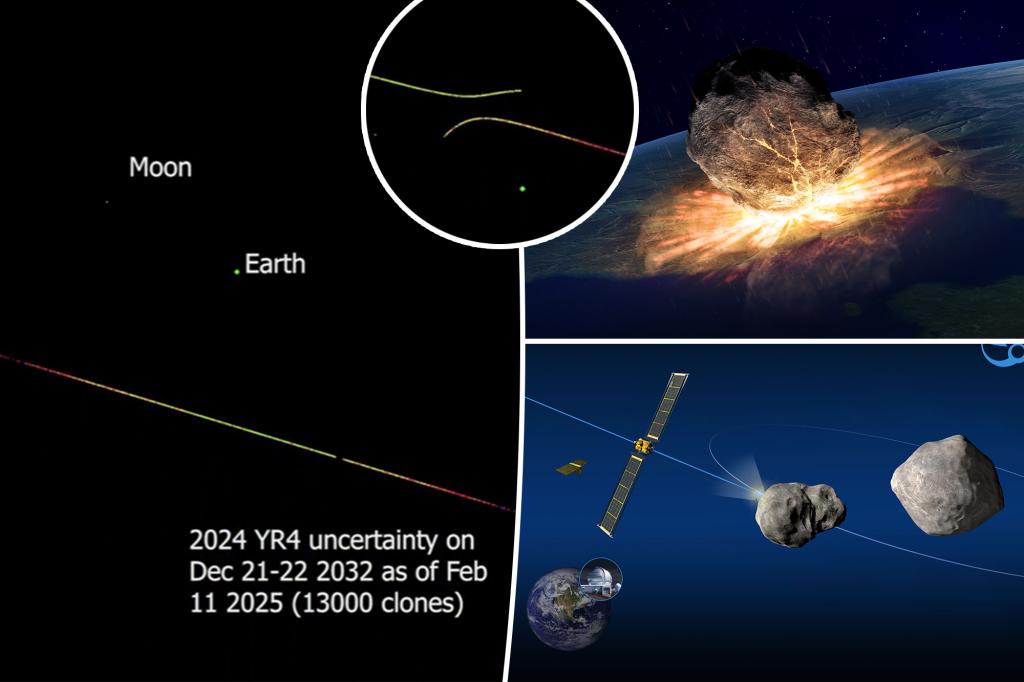
The arrival of the 2024 YR4 asteroid is approaching, and it’s creating quite a stir.
Intriguing simulations illustrate the catastrophic consequences that the “city-killer” asteroid YR4 2024 could unleash upon impact with Earth— and astronomers warn that the moon might also be at risk.
Dr. David Rankin, operations manager at the University of Arizona’s Catalina Sky Survey, highlighted its potential danger, noting that there is an estimated “over ~2% chance of impact on Earth.” He shared a compelling video simulation on Blue Sky Social, depicting the asteroid’s possible collision.
He calculated that the 2024 YR4 asteroid—approximately the size of the Leaning Tower of Pisa—could have nearly a one in 48 probability of striking Earth on December 22, 2032.
The video accompanying his analysis features a graph detailing the exact collision path that could lead to disaster. If this asteroid were to collide with Earth, it could unleash an energy release equivalent to 8 megatons of TNT, devastating an area comparable to the size of Washington, D.C., as reported by SWNS.
In a captivating YouTube animation crafted by 3D artist Alvaro Gracia Montoya, a colossal asteroid decimates a city in a scene reminiscent of a blockbuster disaster movie.
On a somewhat positive note, Dr. Rankin’s estimate is slightly less alarming than current projections, which claim a 2.3% chance of YR4 hitting Earth, placing it near the top of NASA’s list of cosmic threats.
Regrettably, the moon could also be in the asteroid’s trajectory; Rankin calculated a 0.3% chance of it experiencing a significant impact.
Unlike Earth, the moon does not benefit from an atmosphere, so YR4 could collide with it at approximately 30,000 miles per hour, as reported by the New Scientist.
This scenario could also result in an explosion 343 times larger than that of the Hiroshima bomb, leading to a crater measuring between 1,640 and 6,500 feet across.
Fortunately, any potential lunar impact should leave our planet largely unharmed.
Dr. Rankin reassured that while this scenario could eject debris that might make its way back to Earth, he doubts it would pose a significant threat.
He mentioned that the collision “would likely be quite visible from Earth,” as noted by Live Science.
However, if YR4 is indeed on a collision path with our planet, it may not be possible to prevent it.
In a rather foreboding series of X posts earlier this week, UK volcanologist Robin George Andrews warned that there may not be sufficient time to use the DART (Double Asteroid Redirection Test) spacecraft to redirect it. DART was successfully employed to alter the course of the 580-foot-wide asteroid Dimorphos in 2022.
“Given the limited time frame, we might unintentionally redirect it, but not enough to avoid an impact with Earth,” he speculated. “It could still strike, just at a different location.”
NASA has recently enlisted the help of the James Webb Telescope, the world’s most powerful telescope, to investigate 2024 YR4 and assess the potential damage it might inflict if it continues on its current course.
This advanced instrument will assist astronomers in obtaining a more precise measurement of the asteroid’s dimensions by analyzing the heat it radiates using its infrared capabilities.
Fortunately, Dr. Rankin reassures us that there is no need for panic at this point.









